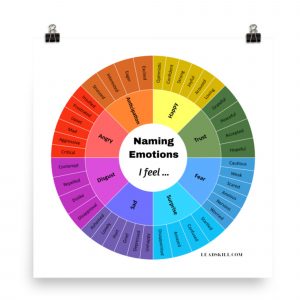What if the feelings you have every day came with a label? That label would tell you what kind of feeling it is, why you’re feeling it, and whether you need to do anything with it or just enjoy, endure, or ignore it. Of course our feelings don’t come with labels, but with a feelings wheel you can at least start naming and making some sense of what you’re feeling.
What are you feeling?
We tend to talk to ourselves in generalities (“I’m a little sad”) or we ignore our feelings altogether – “I’m okay” or “I can’t think about that now”. We do ourselves a disservice when we avoid or dismiss our feelings. They send us important information about how we’re experiencing life.

When people have fewer emotion words in their working vocabulary, they have a tendency to suppress or not manage their feelings well.
This is certainly true for me. I think I have always been sensitive to emotions, especially when I was younger. As I grew older, though, I got tougher and harder. Being an adult, becoming a parent, assuming responsibilities that include leading other people all made me more guarded and protective of my feelings. Over time I grew less sensitive and I also tended to intellectualize emotions.
Well into mid-life, I had to reassess and admit that I had picked up some unhealthy emotional habits. I needed to explore and become friendly again with what I was actually feeling.
Therapists and clinicians will readily tell you that clients who learn to grow their emotional vocabulary are usually better able to start noticing and naming their emotions. This leads to better management of emotions as well.
This makes sense. Some of the key parts of emotional intelligence like self awareness, self control, motivation and social awareness involve accurately naming emotions.
Being able to sense and name what we are feeling contributes to self-awareness. Greater awareness and naming emotions leads to better self regulation. We generate more motivation when we accurately identify the emotional blocks that make us grow discouraged. Finally, listening to others and tuning into their feelings is a powerful form of empathy.

When You're Lost Get a Map and Compass
When I was a young man in scouts I learned to use a map and a compass.
I’ve always enjoyed maps. It’s like having a mental picture of an area even if you’ve never been there before. I grew up in the high plains of New Mexico where you could see for miles and miles out to a flat horizon. Up in the mountains a few hours away there were lots of trees. You rarely can travel in a straight line or even see very far ahead in the middle of a forest.
A compass is an incredibly useful tool if you learn to use it right. It literally points you in the right direction. Today, smartphones have both maps and a compass feature, but you can’t always get service in the mountain wilderness. That’s when you get back to the basic tools.
Emotions to me are a lot like a mountain forest.

When I’m thick in the trees, I sometimes feel lost and need some help finding my way. A good feelings wheel is like a map and a compass. It shows you where all the feelings are, and it orients you to help you find your way. How it does that is something I’ll get to in a minute.
We all need some help navigating the jungle of emotions.
Which Feelings Wheel Can Help You Find Your Way
Google “feelings wheel” and you’ll see you have a lot of options.
There are different colors, layouts and even different words on all the emotion wheels. I found some are based on science, and many others were the product of someone’s creativity. What do you do though if you buy a compass in an attractive case and find it doesn’t have a label for “North” on it?
That wheel might have you going in circles but never finding your way.
I discovered that a scientist named Dr. Robert Plutchik introduced the first real wheel of emotions in 1980 after much research.
The genius of Plutchik’s wheel is that it is formatted like a compass. There are 8 basic emotions and they are arranged in opposite pairs, just like north and south or east and west. The four most common emotions are happy, sad, angry and afraid. The other four basic emotions fill in the space between these: trust, disgust, surprise and anticipation.
Plutchik analyzed human and animal emotions and discovered these eight. Working out from these eight, you can make more granular distinctions among different emotions.
For example, anger includes feeling mad, frustrated, critical, upset, aggressive—there are many options. You can use one of the basic words to describe how you’re feeling. You might also find that a different word captures a specific nuance or expression of your emotion.
This is how you start gaining more self awareness and emotional intelligence.
How to Use an Emotions Wheel
A good feelings wheel is a versatile tool.
First, you can use scan the basic eight emotions and ask if what you’re feeling comes close to any of these. You can then move from the inside of the wheel toward the outside looking for a more specific word that captures what you’re feeling. We gave the example earlier of anger. You can do the same thing with happy or trust, especially as part of a gratitude practice.
This method is what I call general to specific.
A second approach is to let your eyes virtually “spin” the wheel. Start around the outside and move around the wheel either clockwise or counterclockwise and see what word (or words) focus your attention. This is a good approach when you find it hard to label your feeling as just one thing, like “sad”. Maybe you are feeling some sadness, but you’re also irritated (anger) and disappointed (surprise).
Emotions are not always simple; they can be complex mixtures of several different feelings.
Another way to use the wheel is once you have settled on a name (or several) for what you are feeling, look across the wheel at the opposite side and ask yourself, “Am I reacting to something over there?” Disgust can be a reaction to a lack or loss of trust. Anger is sometimes triggered by something we fear. You may also be feeling happy but avoiding any of the feelings of sadness. Try not to judge feelings, but make friends with all of them.
Emotions are signals that are trying to give us valuable information. We have to be willing to listen to the wisdom they sometimes contain.
To tap deeper into your feelings, use the workbook we wrote to help you name, explore and better manage your feelings. Get a copy by filling in the form below. You can also find more emotion wheels and other products like journals, pillows and framed art in our online store.

